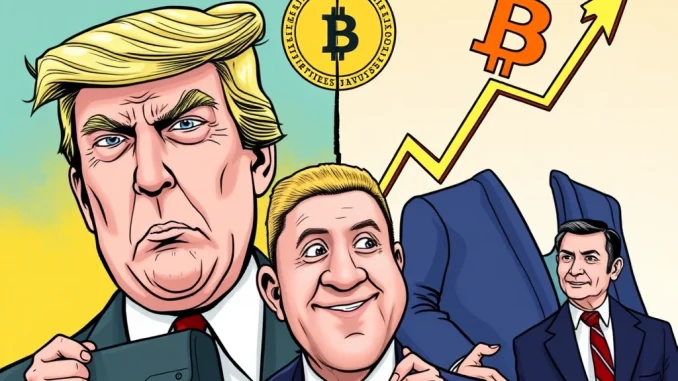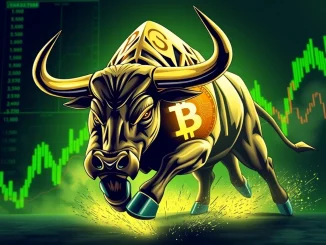
In a surprising twist, could U.S. tariff policies actually be a boon for Bitcoin? Arthur Hayes, the outspoken co-founder of crypto exchange BitMEX, thinks so. His recent comments on social media platform X have ignited a fiery debate within the crypto community, suggesting that policies often viewed as economically disruptive could inadvertently pave the way for Bitcoin’s ascent. Let’s dive into Hayes’s provocative thesis and explore how tariffs might just become an unlikely catalyst for the leading cryptocurrency.
Why Tariffs Are ‘Beautiful’ for Bitcoin: Decoding Hayes’s Bold Claim
Hayes didn’t mince words, declaring, “Some of y’all are running scurred, but I LOVE TARIFFS.” This seemingly counterintuitive stance hinges on his belief that President Trump’s trade policies, characterized by increased import taxes, will ultimately expose and correct underlying imbalances in the global US economy. But how does this connect to Bitcoin?
Here’s the core of Hayes’s argument, broken down:
- Tariffs as Economic Stressors: Increased tariffs disrupt existing trade flows and supply chains. This can lead to higher prices for consumers and businesses, potentially slowing down economic growth.
- Economic Slowdown = Central Bank Action: When economies face headwinds, central banks like the Federal Reserve (Fed) typically step in to stimulate growth. The most common tools? Lowering interest rates and increasing the money supply through quantitative easing (QE).
- Money Printing Fuels Bitcoin’s Fire: Hayes believes the response to tariff-induced economic challenges will be, predictably, more money printing. This is where Bitcoin comes into play. As a decentralized, scarce digital asset with a limited supply of 21 million coins, Bitcoin is often seen as a hedge against inflation and currency devaluation. When central banks inject more fiat currency into the system, the perceived value of scarce assets like Bitcoin tends to increase.
In essence, Hayes is suggesting that tariffs, by creating economic uncertainty and prompting central bank intervention, will inadvertently strengthen Bitcoin’s investment case as a safe haven and alternative to traditional fiat currencies.
The Federal Reserve’s Pivotal Role: Rate Cuts and Quantitative Easing on the Horizon?
A key element of Hayes’s argument rests on the anticipated response of the Federal Reserve. He points to the recent dip in two-year Treasury yields as a significant signal. Why? Because these yields are often seen as a barometer of future Fed policy expectations. A drop suggests that the market is anticipating the Fed to become more dovish – meaning they are likely to cut interest rates.
Furthermore, Hayes hints at the potential for a return to quantitative easing. QE involves the Federal Reserve injecting liquidity into the market by purchasing assets, typically government bonds. This further expands the money supply and is generally considered a form of loose monetary policy.
But why would the Fed resort to such measures? According to Hayes, it’s to counteract the negative economic impacts of tariffs. If tariffs stifle economic growth, the Fed’s mandate to maintain price stability and full employment could compel them to ease monetary policy aggressively. This easing, in turn, becomes the fuel that could propel Bitcoin higher.
Navigating the Uncertain Terrain: Challenges and Counterarguments
While Hayes’s perspective is intriguing, it’s crucial to acknowledge the complexities and potential counterarguments:
- Inflationary Pressures: While monetary policy easing can stimulate growth, it can also lead to inflation. If inflation spirals out of control, it could erode purchasing power and potentially harm the broader economy, impacting all asset classes, including Bitcoin.
- Global Economic Fallout: Tariffs are not isolated events. They can trigger retaliatory measures from other countries, leading to trade wars and broader global economic instability. This uncertainty could create risk-off sentiment, potentially impacting even safe-haven assets like Bitcoin in the short term.
- Alternative Fed Responses: The Fed’s response to tariffs is not predetermined. They might choose to address inflationary pressures more directly, or they might believe the economic impact of tariffs is manageable without resorting to aggressive monetary policy easing.
- Bitcoin Volatility: Bitcoin remains a volatile asset. While monetary policy and macroeconomic factors can influence its price, its inherent volatility means that price movements can be unpredictable and influenced by a multitude of factors beyond tariffs and central bank actions.
Is Bitcoin Poised to Benefit? Expert Opinions and Market Sentiment
Hayes’s view is certainly not universally accepted, but it adds another layer to the ongoing narrative around Bitcoin’s role in the global financial landscape. Many Bitcoin proponents have long argued for its potential as a hedge against inflationary monetary policy. Hayes’s thesis simply presents a specific scenario – tariffs leading to monetary policy easing – that could validate this long-held belief.
The market’s reaction to Hayes’s comments and the evolving tariff situation will be crucial to watch. If investors begin to perceive tariffs as a catalyst for looser monetary policy and increased inflation, we could indeed see a renewed interest in Bitcoin as a store of value.
Conclusion: The Unforeseen Bitcoin Catalyst?
Arthur Hayes’s assertion that U.S. tariff policies could inadvertently benefit Bitcoin is a provocative and thought-provoking perspective. It highlights the interconnectedness of global trade, monetary policy, and the burgeoning cryptocurrency market. While the actual impact of tariffs on Bitcoin remains to be seen, Hayes’s analysis serves as a potent reminder of Bitcoin’s potential role as a hedge against economic uncertainty and the ever-present possibility of inflationary monetary policy responses from central banks. Whether tariffs become Bitcoin’s unlikely ally is a narrative that will undoubtedly unfold in the months and years to come, keeping a watchful eye on both trade policies and the ever-dynamic crypto landscape.



